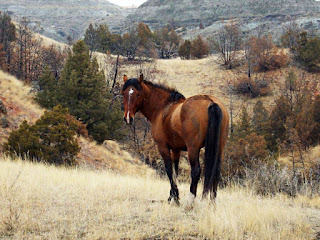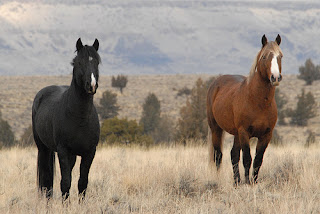Feral horses live in groups called a band, herd, harem, or mob. Feral horse herds, like those of wild horses, are usually made up of small bands led by a dominant mare, containing additional mares, their foals, and immature horses of both sexes. There is usually one herd stallion, though occasionally a few less-dominant males may remain with the group. Horse "herds" in the wild are best described as groups of several small bands who share a common territory. Bands are usually on the small side, as few as three to five animals, but sometimes over a dozen. The makeup of bands shifts over time as young animals are driven out of the band they were born into and join other bands, or as young stallions challenge older males for dominance.
Lavradeiros, a feral horse in Northern Brazil
However, in a given closed ecosystem such as the isolated refuges in which most feral horses live today, to maintain genetic diversity the minimum size for a sustainable free-roaming horse or burro population is 150–200 animals
Feral horses cause considerable damage to the natural environment, including increased erosion of soil and waterways, increased spread of weeds, trampling of native vegetation, consumption of native seedlings leading to reduced biodiversity, sedimentation of waterways and water bodies, destruction of infrastructure, competition with native species and domestic cattle for resources, and spread of disease and parasites to domestic stock and native species. Correlative data collected near Alice Springs indicate that feral horses accelerate gully erosion, foul water holes and natural springs and denude large areas of native vegetation. They may also displace native herbivores like kangaroos by removing food and shelter.
Horses will travel up to 50 km for food and water, which means that they have the potential to cause extensive damage over a very wide range.
The economic impact which feral horses have on pastoralism is poorly quantified but likely to be significant. High dietary overlap indicates that the potential for competition between feral horses and cattle for food is high. Horses compete with stock for water which may be a crucial factor during drought.
For those that consider that all extant wild living populations of horses indeed descended from domestic horses, the term used to describe them is “Feral” and below some examples of its scientific usage:
“The majority of the apparently wild populations around the world are in fact feral. That is they are domestic animals which have returned to the wild” Kiley-Worthington (1987)
“Feral horses are those whose ancestors or who themselves were domestic stock, but have been free running for some time” McDonnell (1999)
“A number of other populations of free-ranging horses or ponies like these at Assateague are found throughout the world. Some live on Islands while others rom over inland regions. Some populations have been studies by scientists, others remain unstudied. All these populations consist of feral animals, animals that have been domesticated but have since returned to the wild. There are no groups that have never been domesticated, and thus there are no truly wild horses in existence.” Keiper (1985)
“Historically, romantic names such as Mustang and Cayuse in North America, Brumby in Australia, and Cimarron, Begual, or Monstreco in South America were applied to free ranging horses. Today’s horses regardless of nomenclature are feral animals whose ancestors were once domesticated.” Berger (1986).
Lavradeiros, a feral horse in Northern Brazil
 |
| Lavradeiros, in Northern Brazil |
However, in a given closed ecosystem such as the isolated refuges in which most feral horses live today, to maintain genetic diversity the minimum size for a sustainable free-roaming horse or burro population is 150–200 animals
Feral horses cause considerable damage to the natural environment, including increased erosion of soil and waterways, increased spread of weeds, trampling of native vegetation, consumption of native seedlings leading to reduced biodiversity, sedimentation of waterways and water bodies, destruction of infrastructure, competition with native species and domestic cattle for resources, and spread of disease and parasites to domestic stock and native species. Correlative data collected near Alice Springs indicate that feral horses accelerate gully erosion, foul water holes and natural springs and denude large areas of native vegetation. They may also displace native herbivores like kangaroos by removing food and shelter.
Horses will travel up to 50 km for food and water, which means that they have the potential to cause extensive damage over a very wide range.
The economic impact which feral horses have on pastoralism is poorly quantified but likely to be significant. High dietary overlap indicates that the potential for competition between feral horses and cattle for food is high. Horses compete with stock for water which may be a crucial factor during drought.
For those that consider that all extant wild living populations of horses indeed descended from domestic horses, the term used to describe them is “Feral” and below some examples of its scientific usage:
“The majority of the apparently wild populations around the world are in fact feral. That is they are domestic animals which have returned to the wild” Kiley-Worthington (1987)
“Feral horses are those whose ancestors or who themselves were domestic stock, but have been free running for some time” McDonnell (1999)
“A number of other populations of free-ranging horses or ponies like these at Assateague are found throughout the world. Some live on Islands while others rom over inland regions. Some populations have been studies by scientists, others remain unstudied. All these populations consist of feral animals, animals that have been domesticated but have since returned to the wild. There are no groups that have never been domesticated, and thus there are no truly wild horses in existence.” Keiper (1985)
“Historically, romantic names such as Mustang and Cayuse in North America, Brumby in Australia, and Cimarron, Begual, or Monstreco in South America were applied to free ranging horses. Today’s horses regardless of nomenclature are feral animals whose ancestors were once domesticated.” Berger (1986).


















